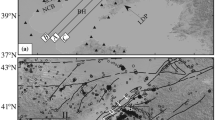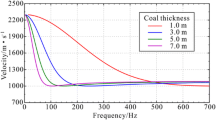Abstract
People have calculated Rayleigh-wave phase velocities from vertical component of ambient seismic noise for several years. Recently, researchers started to extract Love waves from transverse component recordings of ambient noise, where “transverse” is defined as the direction perpendicular to a great-circle path or a line in small scale through observation sensors. Most researches assumed Rayleigh waves could be negligible, but Rayleigh waves can exist in the transverse component when Rayleigh waves propagate in other directions besides radial direction. In study of data acquired in western Junggar Basin near Karamay city, China, after processing the transverse component recordings of ambient noise, we obtain two energy trends, which are distinguished with Rayleigh-wave and Love-wave phase velocities, in the frequency–velocity domain using multichannel analysis of surface waves (MASW). Rayleigh waves could be also extracted from the transverse component data. Because Rayleigh-wave and Love-wave phase velocities are close in high frequencies (>0.1 Hz), two kinds of surface waves might be merged in the frequency–velocity domain. Rayleigh-wave phase velocities may be misidentified as Love-wave phase velocities. To get accurate surface-wave phase velocities from the transverse component data using seismic interferometry in investigating the shallow geology, our results suggest using MASW to calculate real Love-wave phase velocities.









Similar content being viewed by others
References
Aki, K. (1957), Space and time spectra of stationary stochastic waves, with special reference to microtremors, Bull. Earthq. Res. Inst. Tokyo University 35, 415–456.
Arai, H., and Tokimatsu, K. (2004), S-wave velocity profiling by inversion of microtremor H/V spectrum, Bull. Seismol. Soc. Am. 94(1), 53–63.
Behm, M., and Snieder, R. (2013), Love waves from local traffic noise interferometry, The Leading Edge 32(6), 628–632.
Bensen, G.D., Ritzwoller, M.H., Barmin, M.P., Levshin, A.L., Lin F., Moschetti, M.P., and Yang, Y. (2007), Processing seismic ambient noise data to obtain reliable broad-band surface wave dispersion measurements, Geophys. J. Internat. 169(3), 1239–1260.
Boschi, L., Weemstra, C., Verbeke, J., Ekström, G., Zunino, A., and Giardini, D. (2013), On measuring surface wave phase velocity from station–station cross-correlation of ambient signal, Geophys. J. Internat. 192(1), 346–358.
Campillo, M., and Paul, A. (2003), Long-range correlations in the diffuse seismic coda, Science 299(5606), 547–549.
Chávez-García, F.J., Rodríguez, M., and Stephenson, W.R. (2006), Subsoil structure using SPAC measurements along a line, Bull. Seismol. Soc. Am. 96(2), 729–736.
Chávez-García, F.J., Rodríguez, M., and Stephenson, W.R. (2005), An alternative approach to the SPAC analysis of microtremors: exploiting stationarity of noise, Bull. Seismol. Soc. Am. 95(1), 277–293.
Cho, I., Tada, T., and Shinozaki, Y. (2006), A generic formulation for microtremor exploration methods using three-component records from a circular array, Geophys. J. Internat. 165(1), 236–258.
Ekström, G., Abers, G.A., and Webb, S.C. (2009), Determination of surface-wave phase velocities across USArray from noise and Aki’s spectral formulation, Geophys. Res. Lett. 36(18), L18301.
He, X., Xiao, L., Wang, G., Gao, R., Ynag, G., and Yan, S. (2015), Petrogenesis and Geological Implications of Late Paleozoic Intermediate-Basic Dyke Swarms in Western Junggar, Earth Sci. 40(6), 777–796 (in Chinese).
Lin, F., Moschetti, M.P., and Ritzwoller, M.H. (2008), Surface wave tomography of the western United States from ambient seismic noise: Rayleigh and Love wave phase velocity maps, Geophys. J. Internat. 173(1), 281–298.
Lin, F.C., Li, D., Clayton, R.W., and Hollis, D. (2013), High-resolution 3d shallow crustal structure in Long Beach, California: Application of ambient noise tomography on a dense seismic array, Geophys. 78(4), Q45–Q56.
Liu, L., Zhou, J., Yin, F., Feng, M., and Zhang, B. (2014), The reconnaissance of mineral resources through ASTER data-based image processing, interpreting and ground inspection in the Jiafushaersu Area, West Junggar, China, J. Earth Sci. 25(2), 397–406.
Luo, Y., Xia, J., Miller, R.D., Xu, Y., Liu, J., and Liu, Q. (2008), Rayleigh-wave dispersive energy imaging using a high-resolution linear Radon transform, Pure Appl. Geophys. 165(5), 903–922.
Luo, Y., Xu, Y., and Yang, Y. (2012), Crustal structure beneath the Dabie orogenic belt from ambient noise tomography, Earth Planet. Sci. Lett. 313, 12–22.
Margaryan, S., Yokoi, T., and Hayashi, K. (2009), Experiments on the stability of the spatial autocorrelation method (SPAC) and linear array methods and on the imaginary part of the SPAC coefficients as an indicator of data quality, Exploration Geophys. 40(1), 121–131.
Morikawa, H., Sawada, S., and Akamatsu, J. (2004), A method to estimate phase velocities of Rayleigh waves using microseisms simultaneously observed at two sites, Bull. Seismol. Soc. Am. 94(3), 961–976.
Nakata, N., Snieder, R., Tsuji, T., Larner, K., and Matsuoka, T. (2011), Shear wave imaging from traffic noise using seismic interferometry by cross-coherence, Geophys. 76(6), SA97–SA106.
Okada, H. (2003), The microtremor survey method (Vol. 12) (Society of Exploration Geophysicists with the cooperation of Society of Exploration Geophysicists of Japan and Australian Society of Exploration Geophysicists, 2003).
Park, C.B., Miller, R.D., Xia, J., and Ivanov, J. (2007), Multichannel analysis of surface waves (MASW)—active and passive methods, The Leading Edge 26(1), 60–64.
Prieto, G.A., Lawrence, J.F., and Beroza, G.C. (2009), Anelastic Earth structure from the coherency of the ambient seismic field, J. Geophys. Res.: Solid Earth (1978–2012) 114(B7), B07303.
Roux, P., Sabra, K.G., Gerstoft, P., Kuperman, W.A., and Fehler, M.C. (2005), P-waves from cross-correlation of seismic noise, Geophys. Res. Lett. 32(19), L19303.
Sabra, K.G., Gerstoft, P., Roux, P., Kuperman, W.A., and Fehler, M.C. (2005a), Extracting time-domain Green’s function estimates from ambient seismic noise, Geophys. Res. Lett. 32(3), L03310.
Sabra, K.G., Gerstoft, P., Roux, P., Kuperman, W.A., and Fehler, M.C. (2005b), Surface wave tomography from microseisms in Southern California, Geophys. Res. Lett. 32(14), L14311.
Schwab, F., and Knopoff, L. (1970), Surface-wave dispersion computations, Bull. Seismol. Soc. Am. 60(2), 321–344.
Shapiro, N.M., and Campillo, M. (2004), Emergence of broadband Rayleigh waves from correlations of the ambient seismic noise, Geophys. Res. Lett. 31(7), L07614.
Shapiro, N.M., Campillo, M., Stehly, L., and Ritzwoller, M.H. (2005), High-resolution surface-wave tomography from ambient seismic noise, Science 307(5715), 1615–1618.
Snieder, R. (2004), Extracting the Green’s function from the correlation of coda waves: A derivation based on stationary phase, Phys. Rev. E 69(4), 046610.
Song, Y., Castagna, J.P., Black, R.A., and Knapp, R.W. (1989), Sensitivity of near-surface shear-wave velocity determination from Rayleigh and Love waves: Technical Program with Biographies, SEG, 59th Annual Meeting, Dallas, Texas, 509–512.
Tsai, V.C., and Moschetti, M.P. (2010), An explicit relationship between time-domain noise correlation and spatial autocorrelation (SPAC) results, Geophys. J. Internat. 182(1), 454–460.
Wang, K., Luo, Y., Zhao, K., and Zhang, L. (2014a), Body waves revealed by spatial stacking on long-term cross-correlation of ambient noise, J. Earth Sci. 25(6): 977–984.
Wang, K., Luo, Y., and Li, H.,(2014b), The nature of ambient noise over a field in western Junggar Basin near Karamay, China, Proceedings of the 6th International Conference on Environmental and Engineering Geophysics, Xi’an, China, 162–167.
Weaver, R., and Lobkis, O.I. (2001), Ultrasonics without a source: Thermal fluctuation correlations at MHz frequencies, Phys. Rev. Lett. 87(13), 134301.
Xia, J., Miller, R.D., and Park, C.B. (1999), Estimation of near-surface shear-wave velocity by inversion of Rayleigh waves, Geophys. 64(3), 691–700.
Xia, J., Miller, R. D., Park, C. B. and Tian, G. (2003), Inversion of high frequency surface waves with fundamental and higher modes, J. Appl. Geophys. 52(1), 45–57.
Xia, J. (2014), Estimation of near-surface shear-wave velocities and quality factors using multichannel analysis of surface-wave methods, J. Appl. Geophys. 103(2), 140–151.
Xu, Y., Zhang, B., Luo, Y., and Xia, J. (2013), Surface-wave observations after integrating active and passive source data, The Leading Edge 32(6), 634–637.
Yang, Y., and Ritzwoller, M. H. (2008), Characteristics of ambient seismic noise as a source for surface wave tomography, Geochemistry Geophysics Geosystems 9(2), 1256–1256.
Yao, H., van Der Hilst, R.D., and Maarten, V. (2006), Surface-wave array tomography in SE Tibet from ambient seismic noise and two-station analysis-I. Phase velocity maps, Geophys. J. Internat. 166(2), 732–744.
Yao, H. and van Der Hilst, R.D. (2009), Analysis of ambient noise energy distribution and phase velocity bias in ambient noise tomography, with application to SE Tibet, Geophys. J. Internat. 179(2), 1113–1132.
Acknowledgments
We appreciate the Editor Arthur Snoke and three anonymous reviewers for their constructive and detailed comments and suggestions. This study is supported by the project “Deep Geological Investigation of the Karamay Back Mountain Area in Western Junggar, Xinjiang”, China Geological Survey under Grant No. 1212011220245, the National Natural Science Foundation of China under Grant No. 41274142, and the Program of Introducing Talents of Discipline to Universities (Grant No. B14031). We also appreciate Shuttle Radar Topography Mission (SRTM) for providing digital elevation data and Chao Shen for providing software (SurfWave) in surface-wave imaging.
Author information
Authors and Affiliations
Corresponding author
Rights and permissions
About this article
Cite this article
Xu, Z., Xia, J., Luo, Y. et al. Potential Misidentification of Love-Wave Phase Velocity Based on Three-Component Ambient Seismic Noise. Pure Appl. Geophys. 173, 1115–1124 (2016). https://doi.org/10.1007/s00024-015-1160-4
Received:
Revised:
Accepted:
Published:
Issue Date:
DOI: https://doi.org/10.1007/s00024-015-1160-4




